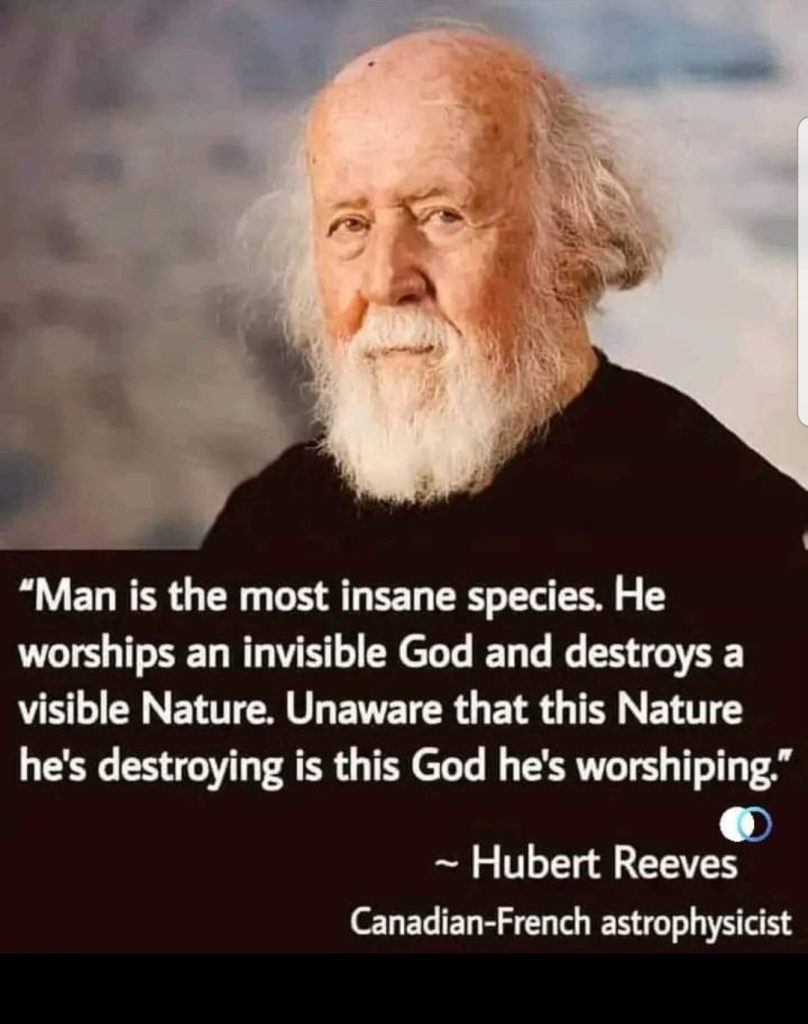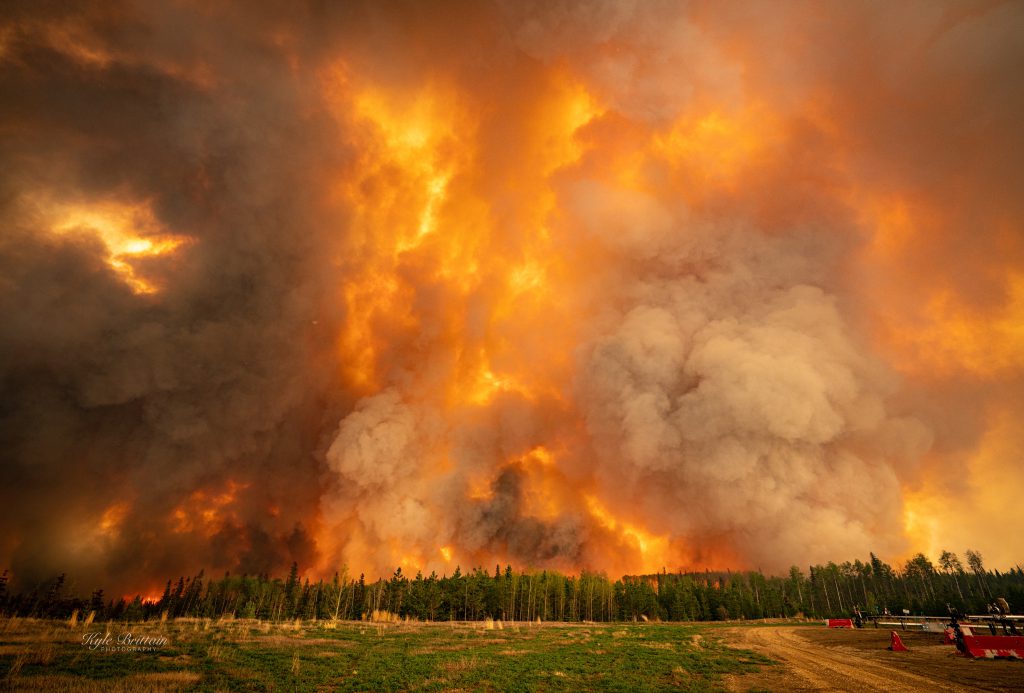
In my view, Homo sapiens proved its evil nature when it began frac’ing the earth. It’s impossible to repair industry’s trillions of fracs and impossible to put that leaking frac’d methane back.
Satan has been unleashed, never to be locked underground again.
Carbon capture and sequestration/storage is an industry con job that doesn’t work, enabled by dirty and or stupid politicians and greedy academics to help the abusive rich keep frac’ing and does not sequester methane.

Hungarian Devil: Detail from Marianna Gartner’s painting, The Hunter.
Finding meaning in the universe with astrophysicist Hubert Reeves, Part 1
Finding meaning in the universe with astrophysicist Hubert Reeves, Part 2

Paris, May 21, 2019
Message to my friends in Canada,
One thing appears clearly today. We are facing a major problem. Our children and grand-children could have to live in a world far different from our world. Our planet earth could become uninhabitable!
We are facing a confrontation between opposite agents: agents of deterioration and agents of restoration. Both agents are becoming more and more powerful. No one knows what the situation will be in fifty years. The future is unknown. It will depend on decisions taken today.
The important thing is not to be optimistic or pessimistic, but be determined to put on top of our agenda: keep the planet habitable.
Sincerely,
Hubert Reeves
2014: Romanian peasants’ revolt against hydraulic fracturing, Chevron tries to bribe with yoghurt

Mutilation of the tree of life via mass extinction of animal genera by Gerardo Ceballos and Paul R. Ehrlich, Sept 18, 2023, PNAS
https://doi.org/10.1073/pnas.2306987120
Significance
We are in the sixth mass extinction event. Unlike the previous five, this one is caused by the overgrowth of a single species, Homo sapiens. Although the episode is often viewed as an unusually fast (in evolutionary time) loss of species, it is much more threatening, because beyond that loss, it is causing rapid mutilation of the tree of life, where entire branches (collections of species, genera, families, and so on) and the functions they perform are being lost. It is changing the trajectory of evolution globally and destroying the conditions that make human life possible. It is an irreversible threat to the persistence of civilization and the livability of future environments for H. sapiens. Instant corrective actions are required.
Abstract
Mass extinctions during the past 500 million y rapidly removed branches from the phylogenetic tree of life and required millions of years for evolution to generate functional replacements for the extinct (EX) organisms. Here we show, by examining 5,400 vertebrate genera (excluding fishes) comprising 34,600 species, that 73 genera became EX since 1500 AD. Beyond any doubt, the human-driven sixth mass extinction is more severe than previously assessed and is rapidly accelerating. The current generic extinction rates are 35 times higher than expected background rates prevailing in the last million years under the absence of human impacts. The genera lost in the last five centuries would have taken some 18,000 y to vanish in the absence of human beings. Current generic extinction rates will likely greatly accelerate in the next few decades due to drivers accompanying the growth and consumption of the human enterprise such as habitat destruction, illegal trade, and climate disruption. If all now-endangered genera were to vanish by 2,100, extinction rates would be 354 (average) or 511 (for mammals) times higher than background rates, meaning that genera lost in three centuries would have taken 106,000 and 153,000 y to become EX in the absence of humans. Such mutilation of the tree of life and the resulting loss of ecosystem services provided by biodiversity to humanity is a serious threat to the stability of civilization. Immediate political, economic, and social efforts of an unprecedented scale are essential if we are to prevent these extinctions and their societal impacts.
Over the last century the pace of many human activities has so accelerated (1), and human overpopulation grown so severe (2, 3), to have created a dramatic global environmental transformation. Most natural ecosystem have been highly modified or have disappeared altogether, and the abundance of wildlife has been greatly reduced (4–9). In well-studied major taxonomic groups, thousands of species and myriad populations have vanished (10–16). The precise number of recent extinctions is impossible to know, but current animal species extinction rates are estimated to be hundreds or thousands of times higher than the background rates that prevailed for millions of years prior to the agricultural revolution (11, 13, 17, 18). The number of vertebrate species known to have become extinct (EX) in the last 500 y would have taken some 10,000 y to vanish under background extinction rates (11). Data on most invertebrates and plants are even scantier; however, some groups also show substantial mutilation (13, 19). To “mutilate” is to cause serious damage, and anthropogenic rapid removal of branches from the tree of life is causing such damage. Furthermore, the potential losses of thousands of endangered (EN) vertebrate species and genera in this century would dwarf the damage done in the last 500 y (10, 20–22). At least a third of land vertebrates are known to have decreasing populations, either through range contraction or shrinking numbers (12). For example, there were around 10,000,000 African elephants at the beginning of the 20th century, and now there are only about 450,000 remaining (23, 24). In several countries, all elephant populations have gone EX, and the great beasts are now absent from many large regions of other countries they once occupied. Surviving populations are scattered and most are declining (25). We are not implying that the eventual extinction of African savannah elephants (or all elephants) is an example of a loss with a likely high cost to future Homo sapiens. We are, however, implying that the patterns illustrated by this well-censused iconic animal are likely replicated in many less-prominent organisms in systems essential to the thriving of future people.
It is well understood that losing species affects the global configuration of Darwin’s “Tree of Life”—the phylogeny of all living entities. Their disappearance is automatically changing the course of evolution by terminating unique pathways of biological change and has profound consequences on issues as diverse as morphological and ecological distinctiveness, many with negative effects on ecosystem structure and function (26–33). However, because phylogenetic relationships and key data on ecological processes are so unevenly available across taxonomic groups and because of the emphasis on species extinctions (34–37), the scientific literature is lacking an overview of the magnitude and impact of today’s already substantial mutilation of the tree of life at higher taxonomic hierarchies.
Here, we assess the magnitude of the current extinction crisis on the land vertebrate part of the tree at the generic level in order to investigate patterns of extinction beyond the levels of populations and species We address the following questions: i) What is the magnitude of the current mutilation measured by recent extinction of vertebrate genera?, ii) How do those current generic extinction rates compare with the background rates, that prevail in the last million years before human impacts?, iii) What are the patterns of global distribution of extinction and endangerment? and iii) What are the implications of these findings for understanding the likely consequences of the mutilation of the tree of life for the future of biodiversity and H. sapiens?
…
![]()
Refer also to:
Read Slick Water to learn the evil truth about frac’ing.
2018: Fracking tied to reduced songbird nesting success
2023: Magnificent Documentary: Living in the Time of Dying, meeting the truth of the climate crisis

Fox Creek Wall of Wildfire photo by Kyle Brittain
